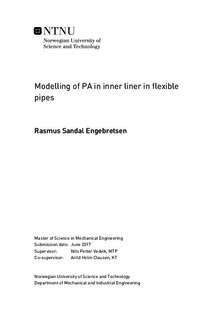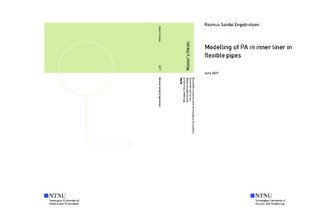| dc.description.abstract | In this report, the mechanical behavior of the semi-crystalline thermoplastic, polyamide 11, has been investigated. The material is commonly used in flexible pipes to ensure safe transportation of oil and gas offshore. The high temperature and chemical agents in the pipe results in changes in the mechanical properties. This has been explored for a virgin- and degraded material by conducting mechanical tests. Further, a numerical model has been developed and validated on a sample with a crack. The laboratory work includes tension and compression experiments at room temperature. In addition, the samples have been subject to two different rates and tested for anisotropy. The effect of stress triaxiality was examined by carrying out a tension test on a specimen with a circular notch. Parameters related to
elasticity and plasticity have been identified analytically by utilizing optical measurements of the tension- and compression tests. The damage model was developed through parametric studies in Abaqus of the notch tension experiment. The fracture test was designed to simulate a loading scenario in a flexible pipe, by applying tension on a compact specimen with a sharp crack.
The two materials tested, show different mechanical responses. The degraded material is stiffer, display a higher yield stress and more propensity to soften after necking. In addition, the degraded material shows more increase in volume and a lower failure load in all experiments. The fracture test reveals that the degraded material has a lower capacity to withstand further development of initial cracks. The failure is attributed to formation and growth of cavities since the surface gets a white appearance. This was less pronounced for the virgin material.
The simulations have been carried out in Abaqus, employing the calibrated material model. Simulations of the tension test show that the material model is able to capture the main characteristics of the material. However, the volume increase is not well predicted. The damage model relies on these predictions and the error is therefore also seen in the simulations of the notch tension test. Further, the ability to carry load is overestimated in the validation of the fracture test. This results in a late damage and reluctant evolution in comparison to the experiment. | |

